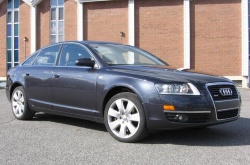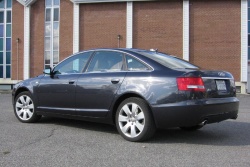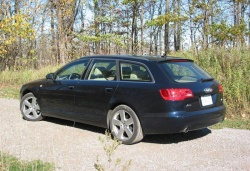 2007 Audi A6 4.2; photo by Chris Chase. Click image to enlarge |
|
More Audi A6 reviews on Autos.ca
Manufacturer’s web site |
Review and photos by Chris Chase
The 2005 Audi A6 is the third generation of this mid-sized luxury car, but if you want to get technical, it’s the sixth generation of a car that began its life as the Audi 100 in 1968.
It was the 1997 design that made the A6 beautiful for the first time, and the 2005 redraw combined an evolution of those good looks with an air of athleticism that has been carried forward to the Audis of today.
All 2005 A6s used a six-speed automatic transmission and Audi’s Quattro all-wheel drive system, leaving most differences down to engine choice and, in 2006, body style, with the addition of a station wagon, or Avant, variant.
The third-generation A6 arrived with a choice of two engines: a 3.2-litre V6 (255 hp/243 lb.-ft.), and a 4.2-litre V8 (335 hp/310 lb.-ft.) that first appeared in the high-performance S4 but was tuned differently for the A6. The V6 was the first Audi engine to use the company’s FSI direct fuel injection system.
A station wagon (called the Avant) was added for 2006, and was fitted exclusively with the 3.2-litre.
  2007 Audi S6. Middle photo by Peter Bleakney. Click image to enlarge |
For 2007, Audi added the S6, a performance variant powered by the same V10 engine (435 hp/398 lb.-ft.) as the bigger S8. Also that year, the V8 got the FSI direct fuel injection system, boosting output to 350 hp and 325 lb.-ft. of torque.
The 2008 A6 got a raft of updates to its lists of standard and optional features, but the mechanicals were carried over from 2007.
2009 brought refreshed styling – including the A6’s first use of Audi’s LED running lights (now a design staple across the industry) – and perhaps more importantly, the addition of a new 3.0-litre, supercharged V6 making 310 hp and 300 lb.-ft. of torque used in all-wheel drive sedan and wagon models. This relegated the 3.2-litre to a new base model with front-wheel drive and a continuously variable transmission.
In 2010, the 3.2-litre engine got an extra 10 horsepower, and was discontinued in 2011, along with the front-wheel drive model.
Fuel consumption estimates for the 3.2-litre Quattro model were 12.1 L/100 km (city) and 8.0 (highway) for the 3.2-litre V6, while the later front-drive version did better, at 11.4/ 7.4 L/100 km.
The 3.0-litre supercharged V6 Quattro model was rated at 12.0/8.0 L/100 km
With the V8, fuel consumption ratings were 13.1/8.8 L/100 km, and the S6’s V10 was rated 15.2/10.4 L/100 km.
Consumer Reports has reliability data for V6-powered models only; they give the car an average to below-average reliability rating.











